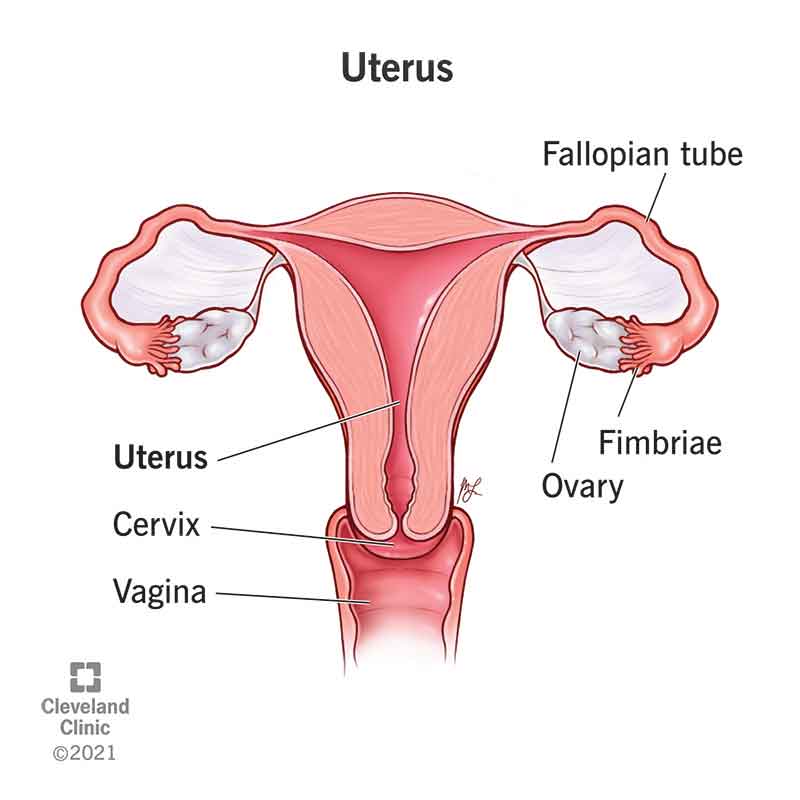Your uterus is a pear-shaped organ that plays a critical role in menstruation, fertility and pregnancy. It’s hollow and muscular and sits between your rectum and bladder in your pelvis. Certain conditions and diseases of the uterus can cause painful symptoms that require medical treatment.
Advertisement
Cleveland Clinic is a non-profit academic medical center. Advertising on our site helps support our mission. We do not endorse non-Cleveland Clinic products or services. Policy

Your uterus is a pear-shaped organ in the reproductive system of females. It’s where a fertilized egg implants during pregnancy and where your baby develops until birth. It’s also responsible for your menstrual cycle.
Advertisement
Cleveland Clinic is a non-profit academic medical center. Advertising on our site helps support our mission. We do not endorse non-Cleveland Clinic products or services. Policy
Your uterus plays a key role in your reproductive health and function. The three main jobs of your uterus are:
During your menstrual cycle, the lining of your uterus goes through several changes. The lining (called the endometrial lining) gets thicker and rich with blood as you near ovulation (releasing an egg from the ovaries). If an egg is fertilized during that cycle, it implants into the lining of your uterus, and pregnancy begins.
Your endometrial lining sheds if pregnancy doesn’t happen (this is your period). This process repeats every menstrual cycle unless pregnancy occurs.
If conception (when the egg is fertilized by sperm) occurs during your menstrual cycle, the fertilized egg implants into your uterine lining. The fertilized egg (called a blastocyte) burrows into the endometrial lining of your uterus (implantation). This is when pregnancy officially begins, and you miss your menstrual period.
Advertisement
Your uterus grows and stretches like a balloon to accommodate your growing baby. It contracts during labor and delivery to help push your baby out of your vagina. After about six weeks, your uterus returns to its pre-pregnancy size (although, it can be slightly larger and show signs of being stretched).
Your uterus looks like a light bulb. It’s about the size of your fist. It’s also commonly described as an upside-down pear. Your uterus has two horn-like organs at the top (the fallopian tubes). It connects to your cervix at the bottom, which is the part that opens (dilates) during vaginal delivery.
Your uterus has several sections:
Your uterus is in your pelvis between your bladder and rectum. It’s supported by your pelvic floor muscles and perineal body. Ligaments in your pelvis, lower back and hips also help hold your uterus in place.
Your uterus consists of three layers:
Your uterus is about 3 inches from top to bottom and 2 inches wide at the widest part. It’s about 1 inch thick and weighs around 1 ounce.
Your uterus is one of the most unique organs in your body. It can stretch from the size of a lemon to the size of a watermelon during pregnancy. Your uterus can be up to 2 pounds when your baby is born. Your uterus shrinks down to its normal size (a process called involution) and position about six weeks postpartum (after giving birth).
Your uterus can lie in several positions. A typical uterus tilts forward at your cervix and points towards your abdomen. This is called an anteverted uterus. Most people have an anteverted uterus.
If you don’t have an anteverted uterus, you might have a:
Advertisement
You may never know you have an irregularly shaped uterus if you don’t have symptoms. In some cases, you’ll have symptoms that require treatment by your healthcare provider.
Several health conditions can be associated with your uterus. Some of the most common conditions are:
If you’re experiencing issues with your uterus, your symptoms might include:
Two ducts (called the Mullerian ducts) fuse together to form one uterine cavity during normal fetal development. For some, these ducts don’t fuse properly, resulting in an irregularly-shaped uterus. Uterine abnormalities are congenital, meaning you were born with them.
Advertisement
Some of the most common abnormalities are:
There are several reasons your healthcare provider may need to use diagnostic tools on your uterus. Some of these reasons include screening for cancer, monitoring pregnancy, helping with fertility issues or diagnosing conditions.
Some of the most common tests involving your uterus are:
Treatment for uterine conditions or diseases depends on the cause of your symptoms. Medications like antibiotics, hormone therapy and surgery are all commonly used treatments.
Advertisement
A hysterectomy is the surgical removal of your uterus, and most likely, your cervix. Depending on the reason for the surgery, a hysterectomy may involve removing surrounding organs and tissues, such as your fallopian tubes and ovaries.
Your uterus plays an important role in menstruation, pregnancy and fertility. Your uterus looks like an upside-down pear and sits in your pelvis between your hips. If you were born with a uterus that’s shaped differently, it could cause you pain. Like most organs in your body, your uterus can develop diseases and infections that require medical treatment, too. Call your healthcare provider if you experience pain in your uterus or have issues with your period or getting pregnant.
From routine pelvic exams to high-risk pregnancies, Cleveland Clinic’s Ob/Gyns are here for you at any point in life.

Last reviewed on 03/08/2022.
Learn more about the Health Library and our editorial process.